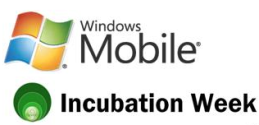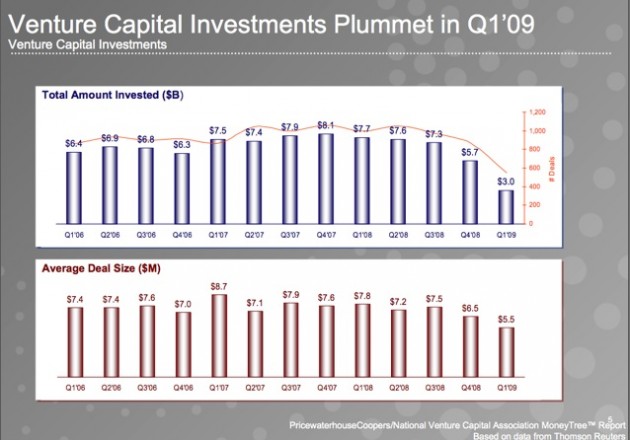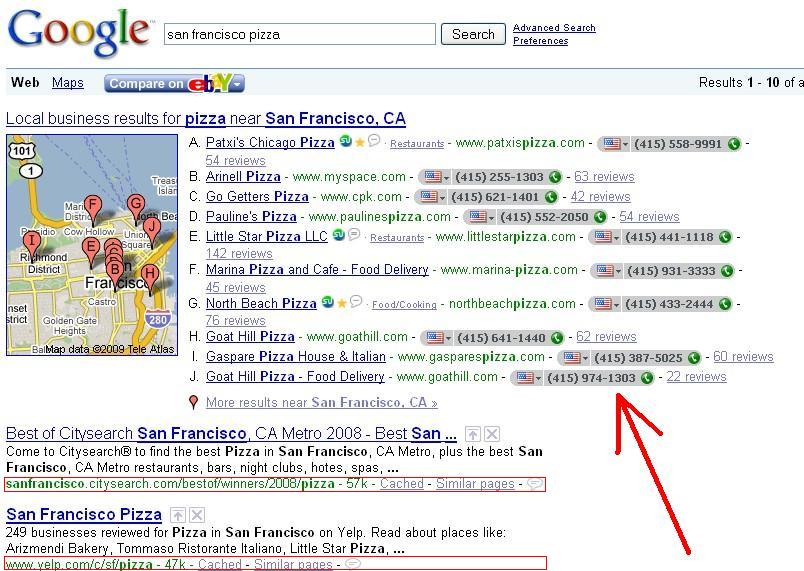The Latest from TechCrunch |  |
| Networks In Motion Wins Mobile Incubation Week, Microsoft’s “American Idol” For Mobile Applications Posted: 18 Apr 2009 03:39 AM PDT
The startup was one of six finalists - selected out of a pool of 50 applications - invited by Microsoft to come present ideas for applications running on Windows Mobile and get certified for the upcoming Windows Marketplace for Mobile, which is supposed to become the big, central commerce and distribution point for WinMo apps that is currently lacking. The company is widely expected to introduce the latest iteration of Windows Mobile at next month’s TechED 2009 conference in Los Angeles (11 May), although devices running Windows Mobile 6.5 won’t start shipping until after the Summer. Microsoft’s a heavyweight in the smartphone OS market but is getting some serious heat from Apple and its iPhone / App Store (which is about to hit 1 billion downloads), and is going to be facing even more stiff competition on the mobile application front from RIM / Blackberry, Nokia and Google Android in the coming years. Microsoft is hoping to up the ante with its new mobile OS and its own version of the App Store, but is evidently going to need a lot of good mobile applications once the Windows Marketplace kicks off, and in that sense hosting a competition was probably a good idea (there will be more of those in Europe and Asia in the near future by the way). Too bad for Microsoft, there was little buzz about the event and press coverage of the outcome is virtually nowhere to be found. Anyway, the six finalists were: Brighkite, the location-based social networking service Yesterday, Senior Business Development Manager on Microsoft's Emerging Business Team Brian Hoskins announced Networks in Motion to be the winner, on Twitter no less. The startup is the maker of Gokivo Navigator, an interesting application that brings real-time turn-by-turn visual and audible directions to GPS-enabled mobile phones, combined with hyper-local search and location-based services. In light of the event, Gokivo got some new features to its core offering, including the ability for users to update their Facebook profile with the specific place they are (address/map). They’re on our radar now. Besides the advice it received from and connections it made with Microsoft developers and external experts at the Incubation Week, Networks in Motion will receive ‘early placement’ in Windows Marketplace for Mobile once it’s launched, and also took home a Zune music player. (Via Digits) Crunch Network: CrunchBoard because it’s time for you to find a new Job2.0 |
| Venture Capital Down 50%. It’s Not Just the Recession, Folks. Posted: 17 Apr 2009 09:01 PM PDT
There's a huge difference between what venture capitalists say and what they do. For much of the last decade some of the same partners that keep saying Silicon Valley will never decline as the startup epicenter of the world are spending every month flying to China. And of course in the post-2000 years every partner said, "Oh we never really got into that whole dot com thing…" Huh. Wonder who did all those deals? Another classic is this one: "Recessions are the best times to start companies! We always invest in downturns! There are fewer competitors, and you get a better caliber of entrepreneur! Dollars can stretch further because salaries and rents are lower! We're not looking to take a company public for years, so why would we run our companies based on the public markets and macro economy?" Bullshit. It fell off a cliff in 2001 and 2002 and it's falling off a cliff now. (More on that in a second.) But there's a difference: Funding levels, returns and the percentage of that money going to new ventures never got nearly as high as they did in the 1999-2000 years. So when we talk about steep drops, we're talking about less of a bubble bursting and more of an industry correcting for more than a decade of scale and liquidity issues. And make no mistake—it's a steep drop. Venture funding fell by 50% nationally from the first quarter in 2008 to the first quarter of 2009, totaling to $3.9 billion, according to Dow Jones Venture Source. That's the lowest total since 1998. PricewaterhouseCoopers and the National Venture Capital Association had it falling farther to $3 billion.
Information technology investments fell 53% year-over-year to $1.7 billion—the lowest since 1997, and the lowest volume of deals since 1995. And clean tech? Well so much for that being the future of the U.S. economy: It fell by 74% to a paltry $117 million. (These numbers according to Dow Jones, see the numbers from PWC/ NVCA in the chart below.)
The results are so different than what we saw in the last downturn that I could spend eight posts writing about them. But I'll distill my take-aways to three points for now. 1. Don't be fooled: This is not just about the recession. Investments in startups declined in the last downturn, but investments in VC firms didn't fall nearly as much. Mostly it was the firms themselves deciding to raise smaller funds. That means venture capital as an industry never had a shake-out from the go-go 1999-2000 era. It's no secret and every VC will admit it: There are a lot of clowns still throwing around a lot of venture money that have no business doing it. (Of course, it's a well-known industry joke that no one thinks he or she is the clown.) Returns, on the other hand, did go down. And they never really got back up, given the amount invested. But the industry is graded on a ten-year time horizon so that didn't matter much. Once returns from 1999 and 2000 fall off that scale, it will. Returns will look at or below the S&P 500 for what is supposed to be a niche, high-risk/high-reward asset class. It takes forever to correct because fund cylces are so long, and the asset class is so illiquid. But it won’t go uncorrected, and the witching hour is getting close. What does this have to do with money going out to startups? VCs are scared for the first time in a long time. There's no obvious high growth sector of the tech economy, and their investors are hit in nearly every nook and cranny of their portfolios. They're not sure how to do their jobs anymore when nothing can go public and acquisitions are few and far between. This is why the amount has fallen so precipitously, especially in Silicon Valley. In past cycles, VCs have pulled closer to home, and the percentage of money going to Valley startups has increased even as the volume of total deals has gone down. Not this time. According to Dow Jones, Bay Area deals fell by 57%– a faster rate than the rest of the country. In clean tech just one deal was done in the Valley. Now, this could point to a savvier Valley entrepreneur who saw the downturn coming. After all, most of the well-known Web 2.0 names like Ning, Slide, Facebook and LinkedIn raised huge rounds just before the economic crisis hit, just in case. That could have artificially boosted the 2008 numbers and artificially lowered the 2009 numbers. We'll have to see how the next two quarters shake out. I expect higher volume of deals in the next few quarters, but also a surge in recapitalizations. More concerning is the free-fall in the percentage going to new deals. During the last downturn it fell to 24%– down from more than 50% during the go-go days and 33% historically. They never got much above that. In the first quarter only 18% of deals went to new companies, according to Dow Jones. 2. Revenge of the steady-eddy. What didn't fall, comparatively? Health care and investments in New England. Both have become the reliable base hits of the venture business. When it comes to healthcare, the vast majority of exits are licensing deals with big pharma or IP acquisitions of device companies. There's almost zero expectation of anyone going public–even in better days– because Sarbanes Oxley has cut off the ability for small market-cap companies to go out. The next Genentech? Don’t hold your breath. Similarly, most Boston VCs never really got the consumer Web. Much of their expertise has remained in areas like telecom and healthcare, and many of their investors have morphed into more financial engineers than company builders. This meant that New England fell from the no. 2 region for venture investment for the first time in 2008, as Southern California and New York ascended. It's now solidly back at no. 2 and investments fell a comparatively tiny 16% in the first quarter, according to Dow Jones. 3. Bye-bye Clean Tech Hyperbole. It's not that clean tech isn't a huge opportunity. It's not that it isn’t an important opportunity. But I've never believed it was the next wave equivalent to the personal computer, as several VCs and even President Barack Obama said during the campaign. For one thing, there's a lot of science that needs to be developed, huge amounts of money that need to be injected, and more government cooperation and subsidies than the US currently has. It's just not the type of investing that most VCs addicted to the crack of quick-to-market, hyper-growth Internet companies can adjust to. Maybe in another ten years, but it’s not the venture guys' salvation anytime soon. Hang in there, startups. Take a hike, clowns.
Crunch Network: CrunchBase the free database of technology companies, people, and investors |
| Obama Spurns Silicon Valley Vets, Names Virginia’s Secretary of Technology As CTO Posted: 17 Apr 2009 05:52 PM PDT
President Obama will be naming Aneesh Paul Chopra as his choice for CTO during tomorrow’s weekly address, as first reported by the Washington Post and confirmed in this press release posted to the White House’s official web site. Chopra currently serves as Virginia’s Secretary of Technology, and has previous acted as the Managing Director for the Advisory Board Company, where he advised executives on health care operations. According to Virginia’s state website, Chopra was recently recognized by Government Technology Magazine’s for excellent ‘use of technology to improve government’, and he was awarded Healthcare Information and Management Systems Society's 2007 State Leadership Advocacy Award. The choice comes after months of speculation, during which many of Silicon Valley’s most prominent figures, including Steve Ballmer, Jeff Bezos, Bill Gates, and Eric Schmidt (among many others) were named as possible candidates. Whether or not some of these people actually wanted the position is another story, but obviously President Obama chose a different route. According to this article published in the Washington Post in 2005, Chopra was not a career technologist before he became Virginia’s Secretary of Technology, but he has extensive experience in policy making. He also co-created a venture fund called Avatar Capital, which invested $11 million in 18 companies (though these figures are likely dated). While he may not be a lifelong coder, Chopra has previously stated that his “primary understanding is from customer need, not bits and bytes”. During his time as Virginia’s SoT, he drove the state’s partnership with Google to become sitemap compliant, and also partnered with Cox and Comcast to broadcast free GED classes to Virginian citizens. According to President Obama’s upcoming remarks, Chopra will “help achieve our most urgent priorities – from creating jobs and reducing health care costs to keeping our nation secure. He will work closely with Chief Performance Officer Jeffrey Zients (also being named tomorrow) and recently-named CIO Vivek Kundra. For another perspective on the news, check out Tim O’Reilly’s post Why Aneesh Chopra is a Great Choice for Federal CTO. Via Scobleizer. President Obama’s full remarks for tomorrow are below:
Crunch Network: CrunchBoard because it’s time for you to find a new Job2.0 |
| CrunchBoard Jobs: Product Manager, Technical Operations Manager Posted: 17 Apr 2009 05:40 PM PDT
Dont’t forget we’re looking for a few good hackers here at TechCrunch. New jobs on CrunchBoard:
Crunch Network: CrunchGear drool over the sexiest new gadgets and hardware. |
| Did Twitter Just Quietly Start Twitter Connect? If Not, It Should. Posted: 17 Apr 2009 05:37 PM PDT
To most people, at its most basic level, Facebook Connect is useful right now simply because it allows you to sign into other services with your Facebook account. This is nice because hundreds of millions of people already have a Facebook login, and Facebook Connect eliminates the need to fill in all your credentials to yet another service. With millions of people already using Twitter and it is exploding in growth recently, Sign in with Twitter would be useful for the same reason. But why sign in with Twitter over Facebook? Well, Twitter touts its integration of OAuth, the open standard for secure authentication, but most end users don’t care about that. What they would care about though is having the ability to sign in to a service with their Twitter names and interact with the micro-messaging platform to say, easily tweet out whatever it is you are doing. If you’re reading an article, you could tweet out the article with one click without leaving the page. If you’re playing a game, you could tweet that out from within the game. Yes, that’s a lot less powerful than some of the proposed uses of Facebook Connect, which promises to port a lot of your online activity into your Facebook profile. Facebook’s grand goal with this seems to be becoming the centralized place for all of your activity online. But Facebook is a lot more complicated than Twitter, and one of the reasons Twitter has exploded in usage is because of its simplicity. And already a ton of services are popping up that are build on top of Twitter, just as Facebook’s Platform allowed services to be built on Facebook. But one key difference is that Facebook is still a relatively closed environment in that regard. Twitter is anything but. Most applications built on top of Twitter seem to have no front-end connection with the service beyond maybe a name that is “Twit____” or a logo. Facebook applications all reside in Facebook. But that’s another reason why Facebook Connect is so important to the social network. It allows other sites to leverage its platform (though not really the Platform) that aren’t affiliated with Facebook. But again, Twitter’s simplicity could make something like Twitter Connect viable. And it would seem to be more open, which developers tend to like. As Yahoo’s Eran Hammer-Lahav wrote about Sign in with Twitter yesterday, “It is Open done right.” Of course, Twitter is still far, far behind Facebook in terms of users. And at the end of the day it would seem the the service that controls the most users will win what ReadWriteWeb’s Marshall Kirkpatrick has named the “calling card” battle. MySpace is in the battle as well, as is Google. But Facebook up until now has seemed to have most of the momentum in this space. Twitter could alter that a bit. If it cares to. [sign in buttons by Peter Denton] Crunch Network: CrunchBoard because it’s time for you to find a new Job2.0 |
| Indie iPhone App Developers Rallying Around OpenFeint Posted: 17 Apr 2009 04:52 PM PDT
The developers behind Trism, Boulder Dash and Pocket God among others have aligned themselves with the OpenFeint platform. Pocket God has recently spent a long time at the top paid app in the App Store, and it still holds the number two spot. Trism, has been one of the most popular games for the iPhone and it has made its developer, Steve Demeter a lot of money — something which Apple itself has played up a few times. Demeter had actually been working on his own platform, called Onyx, but dropped development of that to get on board with OpenFeint. But why are these app integrating OpenFeint? Well, the developers see it as a way not only to add a social layer to their apps — users get profile pages, Facebook-like walls for others to write on, the ability to chat in games and more — but, the platform now includes a new feature dubbed “One Touch iPromote,” which gives users a simple way to find and buy other OpenFeint-supported games their friends are playing. OpenFeint users can invite other users into “lobbies,” where everyone can see what everyone else is playing. A user can then decide to play the same game or click on the link to buy it. Basically, these developers are creating their own sub-ecosystem outside of the App Store to get the word out about their games. And that’s an enticing proposition for a lot of indie app developers who don’t have the marketing resources of some of the bigger game studios that are now moving in on the iPhone platform. And when it includes games that already rose from nothing to become hits, like Trism and Pocket God, the idea is even more enticing. And this is a smart play by OpenFeint founders Jason Citron and Danielle Cassley (who named the platform after their early hit game for the iPhone Aurora Feint) because it gives developers a reason to use their platform rather than simply go with Facebook Connect (which you can also use with OpenFeint). Facebook unveiled Facebook Connect for the iPhone at SXSW a few weeks ago, as an easy way for developers to leverage the huge social network to add a social layer to apps. So what’s in it for OpenFeint? “One Touch iPromote will be based on revenue sharing. When a user clicks on a game in a Feint Lobby and then goes on to buy that game the developer and OpenFeint will get a percentage of that sale,” an OpenFeint spokesperson tells me. There are now 21 iPhone games using the OpenFeint platform. Version 1.5 of OpenFeint was unveiled today with this new One Touch iPromote feature. Crunch Network: CrunchBase the free database of technology companies, people, and investors |
| Another Contender Emerges: Posterous Takes On TwitPic With New API Posted: 17 Apr 2009 03:10 PM PDT The race is on to become the dominant media sharing site on Twitter, with favorites like TwitPic and newcomers including PhotoBucket’s TwitGoo vying for popularity as Twitter begins to hit the mainstream. Now Posterous is looking to join the race with a new API that developers can integrate into their Twitter apps with a minimal amount of effort. We’re big fans of Posterous, the dead-simple blogging tool that makes it incredibly easy to post text, photos, and other media online. To post a photo or post to the site, you simply send an Email message to the generic post@posterous.com address, and the site does the rest. And you can optionally have the service automatically syndicate each of these posts to Facebook, Twitter, Flickr, and a number of other services. Now, Posterous is looking to become even more convenient. Its new API allows developers to add Posterous support to their Twitter clients, which means you’ll soon be able to send photos to the service from your iPhone or desktop much the same way you would with TwitPic or one of its many competitors (assuming the clients integrate the service - more on that later). But Posterous isn’t looking to simply serve as yet another competitor offering a near-identical featureset. Instead, the company believes that its blogging platform is superior to the basic photo galleries offered by other services (and Michael agrees - he’s been posting his photos here). The service supports multiple photo uploads at once, which are automatically placed into photo galleries, and can also generate embeddable players for audio and video files (though its API is starting off with support for images only). Users can optionally use their own domain names with the service, which means that they can more easily track analytics. And finally, users can download media in its original format, while some competitors only offer compressed versions for download. I prefer Posterous to the other image platforms because it’s much more flexible. But as I wrote yesterday about TwitGoo, the key to the service’s success (at least as a TwitPic alternative) will lie in getting integrated into popular Twitter clients like TweetDeck or Tweetie. It’s not clear how selective these clients are at this point, but they’re going to have have to start making choices, otherwise users are going to be overwhelmed with the number of services they have at their disposal. That said, Posterous is making the process as easy as possible on developers, as it uses the “exact same methods, parameters, and response codes” as TwitPic. Crunch Network: CrunchBoard because it’s time for you to find a new Job2.0 |
| A New Business Model For Skype: Turning Phone Numbers On The Web Into Paid Ads Posted: 17 Apr 2009 02:43 PM PDT
While eBay prepares to unload Skype via a sale or IPO next year, it is busy looking for new ways to make money off its 405 million global users. They already account for an estimated 8 percent of international calls, and many of them are increasingly paying for SkypeOut calls to regular phones. Its revenues last year were $551 million, but it wants to get to $1 billion by 2011. To get there, it might have to start thinking local. In fact, it has already started trials in Europe and New Zealand with Yellow Pages businesses that turn business phone numbers on the Web into free calls. Mike Boland at the Kelsey Group explains the concept:
The SkypeFind feature he mentions is basically a local business directory within the Skype client which nobody uses But currently there is a browser plug-in that works with Skype 4.0, the latest version, that turns any phone number on the Web or search result into a clickable Skype call. In order to use the feature, you need to pay the normal SkypeOut rates. The idea Skype is playing with is to make those calls, or at least some of them, free to consumers. Instead, a Yellow Pages company would buy up the calling minutes in bulk and either offer it as part of the fees it charges businesses to list their numbers in its directory or charge the businesses on a click-to-call basis. How they decide to price it will probably vary depending on the type of businesses being called. Lawyers and plumbers, for instance, would be more likely to pay for phone leads on a click-to-call basis. For other businesses, the Skype feature would act more as a retention strategy. Click-to-call ads have been tried before, but this turns the actual phone number into an ad. Click it, and you call the business you were looking for, and the call is paid for by either the business or the Yellow Pages partner. The $32 billion Yellow Pages industry is quickly moving to the Web and Skype has the ability to light up any business phone number found on the Web. Presumably, the Yellow Pages partners would only pay for numbers in their directories, so Skype would have to come up with a way to indicate which calls are free and which ones are not. And there is no reason to limit this to local calls. As people continue to use Skype increasingly for free long distance calls, making money from local calls might be the key to getting to that $1 billion in revenues.
Crunch Network: CrunchBase the free database of technology companies, people, and investors |
| Laguna Is A Hacker At Heart, And Other Fine Jobs At TechCrunch Posted: 17 Apr 2009 02:33 PM PDT
We love our new TechCrunch world headquarters in downtown Palo Alto, and we’re working hard to fill it with smart, hardworking and fun people. Team members needed: Developers (2): We think it’s critical that next-generation media companies actually build product and test new apps developed by other start-ups. It gives us street cred and keeps us engaged in the community. It’s also creating new assets for our business. In the last year, in addition to launching our own CrunchBase structured-wiki product and API, Henry and Mark were some of the first developers to have access to roll out Facebook Connect, Google App Engine and Yahoo! BOSS search. And we have many more great projects ahead of us. Rails developers preferred, but raw talent and drive are most important to building out our team. Great developer perks include our new (used) Segway, Microsoft Surface, outdoor deck, unlimited supply of caffeine, and friendly dog-wonder, tester-hacker Laguna. We also host major events throughout the year and lots of cool start-ups pass through our office every day. Developer, Summer Intern. We have one paid internship available for a developer. Open to college students. Our paid summer internships for CrunchBase and Events have been filled, but if you’re interested in working part-time at TechCrunch this summer for academic credit (or just great experience), please send your resume to gene [at] techcrunch [dot] com. Crunch Network: MobileCrunch Mobile Gadgets and Applications, Delivered Daily. |
| Gmail Now Tells You Who You Want To Email Posted: 17 Apr 2009 01:07 PM PDT  Not sure who else to add to that group email? Gmail Labs now has a useful “suggest more recipients” feature that suggests contacts that you might want to include in a group email based on the people you’ve grouped together as email recipients in the past. For example, if you often send family emails to your mother, father, husband, sister and brother, when you start composing an email to your mother and father, Gmail will suggest adding your sister, husband and brother. The feature is triggered only after you’ve added at least two recipients to the email. To enable the feature, go to Gmail Labs and turn it on as a setting. This clever feature is just one of the many nifty innovations that has come out of Gmail Labs, including offline access, contact time zones, search suggestions, an undo button, multi-pane viewing, and many more. Crunch Network: CrunchGear drool over the sexiest new gadgets and hardware. |
| Hulu For The iPhone? Yes, Please. But Don’t Get Your Hopes Up Just Yet. Posted: 17 Apr 2009 12:54 PM PDT
Sure, there are other iPhone apps that offer video streaming such as Joost, i.TV and TV.com, but none come close to Hulu in terms of content and public appeal so far. But the most interesting part may be that the Hulu app would apparently work over 3G connections, as well as WiFi. The current crop of video streaming apps are mostly confined to WiFi usage — no doubt at least in part because AT&T doesn’t want streaming video clogging the pipes. In fact, there’s a rumor going around right now that AT&T is the reason that Apple rejected an app by SlingPlayer from the App Store. That hasn’t been confirmed, but the thought is that just like the supposed Hulu app, the SlingPlayer app would have worked over 3G. So if a Hulu app does carry the same functionality, it stands to reason that it would be rejected as well. But, the new iPhone 3.0 software, due this summer, touts live video streaming as one of its core new features. Perhaps Hulu could work with Apple to get such an app working. And the rumored new version of the iPhone supposedly will offer faster connection speeds, which could help ease the bandwidth strain AT&T would see on its end. Hulu has gotten itself into a bit of controversy on the web recently as it has been in a sparring match with the popular media center software startup Boxee. Hulu’s content partners, it seems, don’t want their content easily accessible on a television — a process which Boxee greatly simplifies for many people. But their position for Hulu on a device like the iPhone could be different because it gives them another outlet to monetize their content via ads. Of course, you have to wonder what Apple would think about a Hulu app, because it sells through iTunes many of the television shows Hulu streams for free. You can’t currently browse to Hulu through the iPhone’s web browser because the iPhone doesn’t support Flash, which Hulu uses. Business Insider’s Dan Frommer tells me his source on this Hulu app is a trusted one, but that the time frame for the launch is hazy. That, mixed with the potential problems with AT&T and Apple leads me to warn everyone: Don’t get your hopes up just yet. [photo: flickr/tivol] Crunch Network: MobileCrunch Mobile Gadgets and Applications, Delivered Daily. |
| People Who Switch To Macs Like To Dance, And Other Strange Hunches Posted: 17 Apr 2009 11:37 AM PDT
it’s been only three weeks since the launch of Q&A site Hunch, but already it’s amassed answers to 4.3 million questions. By taking visitors through a series of questions to get to know them better, Hunch can begin to make guesses about the right kinds of answers for each individual by making correlations across between people who answer similarly across different topics. It’s sort of like collaborative filtering for information. Co-founder Caterina Fake of Flickr fame shares some of the correlations Hunch has been able to find so far. Some of her findings: * People who believe that alien abductions are real are more likely to blame Nancy Pelosi for the financial crisis. * One of the best predictors of whether people agree they should switch to a Mac: whether they like to dance. Are PC users less fun? The data has spoken. * Fake ID users are more likely to be happy at startups. Also, people who like sports video games are more likely to have had a broken leg at one point (which would explain why they like to sit on the couch and play football instead of go out and, you know, actually play football). And on the subject of Facebook versus Twitter, the Hunch data suggests that “Facebook people” are more social than Twitterers in actual social situations like a party. Facebook people mingle with more people, including strangers, whereas Twitterers stick to people they know. Other differences? Facebook people spend more on shampoo and like to drink more. Whereas “Twitterers report that they have oily skin.” In other words, Twitter is for geeks. I knew it! Don’t tell Oprah Hunch’s data set will become available to researchers next week through a special “researchers API.” Can’t wait to find out what other correlations come out of it. (Photo by Ira Mejías) Crunch Network: MobileCrunch Mobile Gadgets and Applications, Delivered Daily. |
| Twitter Working On A New Tweet Feed, Testing It With FriendFeed Posted: 17 Apr 2009 11:28 AM PDT
This new feed is interesting because up until now, FriendFeed has been one of the few services with access to Twitter’s XMPP feed. Some have called the XMPP feed the “fire hose,” because it sends out a massive amount of data quickly, as opposed to importing a feed by way of RSS, which is limited and slow. But XMPP has been anything but fast these past few months, so a new solution was needed. This new feed is still experimental, but here’s what we know: It’s HTTP-based, and, at least for FriendFeed, it will replace the XMPP feed. Twitter is using FriendFeed as a testing ground for it, but eventually, if it works, it should be opened to other services. “Hopefully we can identify what works and what doesn’t. Whatever we determine from this test, will inform how we move forward,” Twitter’s Jason Goldman tells me. And it has been a bit glitchy so far. When FriendFeed first implemented it on Wednesday, it was nearly instaneous — FriendFeed co-founder Paul Buchheit sent out a tweet and one second later it was on FriendFeed. But in subsequent days, the feed slowed down quite a bit, sometimes taking as much as 20 minutes for a tweet to come though. It was a bug that Twitter believes it has fixed, according to Buchheit. Twitter is an important part of FriendFeed, as tweets make up a high percentage of content on the site. Of course, Twitter is becoming an important part of a lot of services, so hopefully this HTTP-based feed will one day mean near-instantaneous tweet access for all. [photo: flickr/uwe hermann] Crunch Network: CrunchBase the free database of technology companies, people, and investors |
| TechCrunch Poll: How Much Did VC Investing Drop In The First Quarter? Posted: 17 Apr 2009 10:44 AM PDT
VCs are feeling the heat from the recession. Money, both outgoing and incoming, isn’t drying up completely, but the numbers keep going down. In terms of exits, during the first quarter of 2009 there were zero venture-backed IPOs and only 56 M&A transactions, according to the National Venture Capital Association, down from five IPOs and 106 M&A exits in the first quarter of 2008. The disclosed value of those M&A deals in the first quarter of 2009 was $645 million, down from $4.5 billion a year ago. And money going into venture funds from limited partners has also plummeted over the past year. Only 40 funds raised new money during the quarter, down from 71 the year before (1Q08) and 47 the previous quarter (4Q08). In dollar terms, the total raised in the first quarter was $4.3 billion, down 39 percent from the year before (1Q08). And now we are waiting to find out how much money VCs put into startups during the first quarter. Mind you that VC investing for the fourth quarter of 2008 already hit a low, with the total dollar amount invested in venture financings at $5.4 billion, down 33 percent from the fourth quarter of 2007 (when it was $8.09 billion). That number was also down 26 percent from the third quarter of 2008 (when it was $7.3 billion). We’re not too confident that the report card for the first quarter of 2009 will be any better. Considering the continued drops in exits and fund inflows from LPs, the number might not be pretty. So how bad will it be? Take your guess in the poll below. Crunch Network: CrunchGear drool over the sexiest new gadgets and hardware. |
| Um, Facebook. Your Developer Site Has Been Defaced Posted: 17 Apr 2009 08:42 AM PDT  It looks like the mobile page on Facebook’s developers wiki has been Crunch Network: CrunchBoard because it’s time for you to find a new Job2.0 |
| You are subscribed to email updates from TechCrunch To stop receiving these emails, you may unsubscribe now. | Email delivery powered by Google |
| Inbox too full? | |
| If you prefer to unsubscribe via postal mail, write to: TechCrunch, c/o Google, 20 W Kinzie, Chicago IL USA 60610 | |
 There’s a good chance you didn’t even know it was going on, but last week
There’s a good chance you didn’t even know it was going on, but last week 




 Yesterday, on its Twitter API Wiki, Twitter quietly
Yesterday, on its Twitter API Wiki, Twitter quietly  Gaming has proven to have huge appeal on the iPhone. Because of that, there are a thousands of games in the App Store — which is great for consumers, but it can also be overwhelming. And it can be frustrating for developers who can see their work easily lost in the sea of apps. The iPhone social platform
Gaming has proven to have huge appeal on the iPhone. Because of that, there are a thousands of games in the App Store — which is great for consumers, but it can also be overwhelming. And it can be frustrating for developers who can see their work easily lost in the sea of apps. The iPhone social platform 



 Ask people what their favorite website is, and increasingly you’ll hear
Ask people what their favorite website is, and increasingly you’ll hear 
 If you’ve been a user of
If you’ve been a user of 
No comments:
Post a Comment